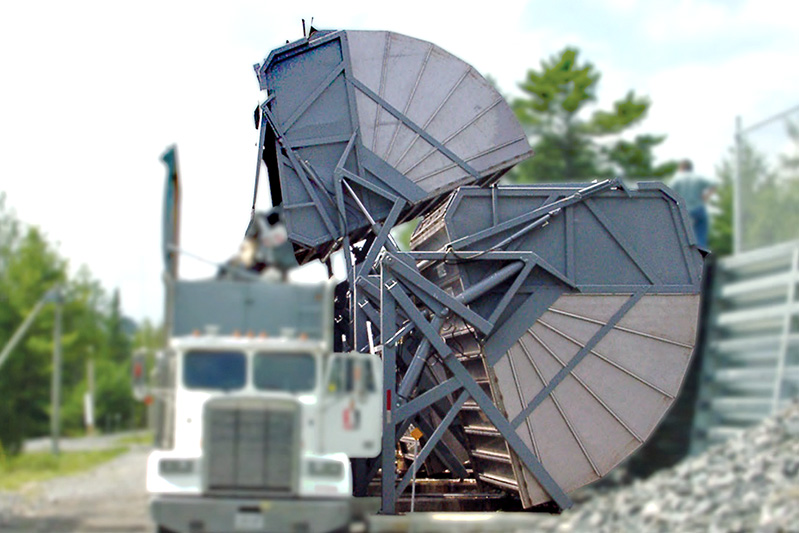WSP Canada Inc. representatives attended the Municipality of South Dundas March 3 Committee of the Whole meeting, where they outlined their preliminary assessment for the proposed Matilda Transfer Station. The report, which can be found in the meeting’s agenda package, included diagrams and a brochure. Courtesy Photo
MORRISBURG – The Municipality of South Dundas council has tentatively chosen a direction for the proposed Matilda Transfer Station.
Most of the township’s politicians were updated on landfill expansion and transfer station plans during its March 3 Committee of the Whole meeting. Councillor Lloyd Wells was absent. The meeting agenda included a memo, along with diagrams and a brochure for a Transtor Unit, from WSP Canada Inc.’s Cristina Olarte and Jennifer Brown-Hawn outlining their preliminary assessment of the Matilda Transfer Station. The two attended the March 3 meeting to discuss their assessment and answer questions.
“As a follow up to our last council meeting where we approved WSP to start the process of looking at preliminary assessment for our transfer station, WSP is here to go through the documentations that were presented to council, which has two options and I’ll have Jennifer and Cristina go through them,” chief administrative officer Shannon Geraghty said. “And then from there, depending on which way council wants to go, WSP will go back, prepare a feasibility study as well as some other studies that need to be done.”
The report stated that in 2021, South Dundas had a population of roughly 11,519, and waste generation of roughly 4,310 tonnes per year. The transfer station being proposed is projected to last for a 30-year period. The report also includes a table outlining the projected population and waste generation for that 30-year period, using a growth rate of 0.5 per cent.
“The table considers 10 per cent and 30 per cent waste diversion rates and estimates the number of bins required considering hauling off-site twice a week,” it said. “Also, the use of Transtor units, which allow for the compaction of waste disposed, saving space and reducing the amount of hauling trips.”
The report detailed the number of bins needed for waste disposal and for recycling, as well as an estimation of the number of Transtor units needed. It was noted that a permanent power supply is required to operate the Transtor units. Two transfer station layout options were presented to council for consideration: bins at ground level, and a high-level retaining wall.
A table comparing the cost of each option was included in the report, showing that Option 2, the retaining wall, as the more expensive option at roughly $955,362. Option 1, bins at ground level, was estimated to be roughly $439,012. The key difference between the two was the added cost of the following items for the retaining wall option: fill placement, retaining wall, two sets of stairs, and a guard rail. In addition, if Transtor units are used, the team said the cost is roughly $100,000 plus the electricity required to use them.
“The transfer station options as presented in this report will allow the municipality to continue to offer waste disposal services to their residents. If the transfer station is constructed and operation begins in the short-term, this may extend the remaining lifespan at the Matilda landfill,” the report stated. “As part of the hauling costs and disposal tipping fees, it is recommended that the municipality approach several service providers since pricing tends to vary depending on the hauling distance, service provider capacity, and final disposal facility remaining capacity.”
Mayor Steven Byvelds commented on the cost of getting power installed. Brown-Hawn said if council decided not to pursue the compactors (Transtor) units right now, they could still be added later.
Byvelds also inquired about the potential that the land under discussion might have garbage already buried there. Olarte said this wouldn’t prohibit the project, but the garbage would need to be excavated. The mayor said he’s worried about the cost of having to remove all that waste because the amount of waste that’s been buried is unknown.
Councillor Archie Mellan, Coun. Don Lewis, and Deputy Mayor Kirsten Gardner each agreed on Option 1 for now, noting that Option 2 could work in the future. The decision to go with Option 1 came down to cost differences, and the potential for significant additional costs with Option 2 should there be a large area of buried waste that needs to be removed.
“I agree with Option 1,” Gardner said. “I think the compactor is something that could be explored at a later time. Option 2, you know, it looks nice and neat and maybe for accessibility it’s a little easier but the price jump in my mind is just not worth it, so I would go with simple form of Option 1.”
Looking into the future, the mayor said he would have chosen Option 2. However, he also acknowledged the financial unknowns with this option. He agreed that they could start with Option 1 now and it would still be possible for a future council to move into Option 2, which he confirmed with Brown-Hawn. He also noted that council hadn’t seen either option in person yet, which is something they’ve said they’d like to do before making a final decision.
“Okay, let’s go check out some of them and then we know where we’re going. I think that’s the best. Thanks Jennifer and Cristina. For now, sorry we couldn’t give you the answer today, but we need to do investigating,” he said. “And Coun. [Lloyd] Wells is not here and I’m sure he’d like to put his input on this one too.”
WSP’s report is available in the March 3 Committee of the Whole agenda package. The meeting itself can be viewed on the municipality’s YouTube page.











